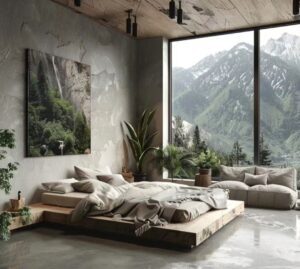Why Discuss Feng Shui Bedrooms?
We spend at least one-third of our day in the bedroom. It’s not just for sleeping, but also a place to relax and rejuvenate. A well-designed bedroom helps us unwind, while a poorly arranged one can cause discomfort and hinder daily tasks. Applying feng shui principles to bedroom design creates a harmonious space for rest and recovery.

Basic Principles of Feng Shui Bedrooms
Balancing the Energy Field
The energy field is crucial in a feng shui bedroom, representing the flow of energy and overall atmosphere. It should be balanced, neither too lively nor too stagnant. This balance promotes relaxation, deep sleep, and waking up refreshed. To maintain it, ensure good ventilation for fresh air and energy flow, but avoid strong drafts. Proper lighting with natural light creates a bright, warm environment, stabilizing the energy field and attracting positive energy.

The Five Elements Theory
The five elements theory is central to feng shui, including metal, wood, water, fire, and earth. They interact through generation (one element promotes another) and control (one element inhibits another). In bedroom design, use these relationships for harmony. For example, if the main color is green (wood), add some blue (water) elements, as water generates wood, boosting vitality. Avoid excessive control, like too many fire elements (red, bright lights) that can inhibit metal elements, creating a hot, restless atmosphere.
Considerations for Bed Placement
Headboard Against a Wall
Positioning the headboard against a solid wall provides a sense of security and blocks direct air currents, stabilizing the energy near the headboard for better sleep. Ideally, place the headboard directly against a wall, avoiding windows or doors. If space is limited, use screens or bookcases to simulate a wall effect.
Avoid Facing the Door Directly
Having the headboard directly opposite the door is a major taboo. Doors bring air currents and light, which can disrupt sleep and cause restlessness. They also compromise privacy. To adjust, place the headboard at a 90-degree angle to the door or use furniture like wardrobes or bedside tables as a barrier.

Avoid Facing Mirrors Directly
Mirrors reflect air currents and light, which can disturb sleep and cause anxiety if the foot of the bed faces them directly. They may also reflect light at night, startling you. Place mirrors on the side or above the bed, or cover them when sleeping. Choose mirrors with frosted surfaces or decorative patterns to reduce reflection.
Treatment of Windows and Curtains
Size and Position of Windows
Windows should be proportional to the room’s size for adequate lighting and moderate air flow. Large windows can cause energy loss and temperature fluctuations, while small ones may lead to a dim, oppressive atmosphere. Properly sized windows maintain a stable energy field and positive energy.
Selection and Coordination of Curtains
Choose thick, light-blocking materials like velvet or linen for curtains to block external light and noise, ensuring privacy and a comfortable sleep environment. Opt for soft, warm colors like light blue, beige, or light pink to relax the mind. Avoid bright, stimulating colors that may cause excitement. Simple, harmonious patterns prevent visual clutter. Coordinate curtains with the bedroom’s overall style and color scheme for a cohesive look.
Selection of Colors and Decorations
Principles of Color Coordination
Select soft, warm colors for the bedroom to promote relaxation and a cozy atmosphere. Use similar color schemes, like light blue with white or beige with light pink, for harmony and depth. Balance colors to prevent one from dominating. For example, if the main color is light blue, add beige accents to balance the coolness.
Placement of Decorative Items
Decorative items add beauty and personality to the bedroom. Choose plants that purify the air and add vitality, placing them away from the bed to avoid oxygen competition. Select wall hangings with auspicious meanings, avoiding placement directly opposite the headboard. Add small decorative items like crystals or ceramics, but avoid clutter for a tidy, visually appealing space.

Handling of Electronics and Clutter
Rational Placement of Electronics
Electronics emit electromagnetic radiation and noise, potentially affecting health and sleep quality. Place them away from the headboard and choose low-noise models. Use headphones or sound-absorbing materials to minimize noise. Turn off unnecessary electronics before bed to reduce interference.
Organization and Storage of Clutter
A tidy bedroom is essential for smooth energy flow and mental well-being. Regularly organize and clear away unnecessary items to prevent clutter. A clean environment promotes relaxation and improves overall quality of life.
Ms. Cen will delve into these design aspects in future articles.

